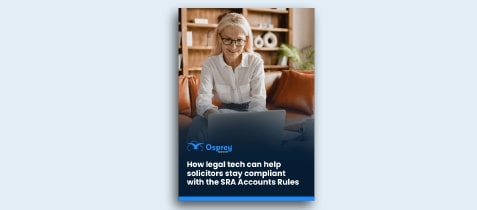Contents
How legal tech can help solicitors stay compliant with SRA Accounts Rules
Guest author: Alex Simons MAAT – New Business Manager – The Law Factory
Can legal tech help you meet the SRA Accounts Rules?
The simple answer is YES!
This guide will provide advice and guidance on how your legal tech – primarily case management and legal accounts software (CMS) – can assist in meeting the requirements of the SRA Accounts Rules. To ensure your firm is SRA compliant and prepared for SRA audits, legal tech can help you gain control and visibility of your office and client accounts with ease.

The SRA Accounts Rules
The SRA Accounts Rules are a core part of every solicitor’s practice. More practices are intervened by the SRA because of breaches of the SRA Accounts Rules than for any other reason. This is because they are so easy to fall foul of. Breaches may be due to mismanagement or a lack of control over the financial aspects of the firm. In many cases, having out of date case management and accounts software is a large contributing factor.
The 12 SRA Accounts Rules and how legal tech can help
This guide reviews each main rule and identifies where legal tech can assist with staying compliant.
SRA Accounts Rules – Part 2: Client money and client accounts
Rule 2: Client money
Rule 2 states client money is money held or received by “you” relating to services delivered by “you”. It can be for the firm’s fees, for a third party – in relation to work undertaken by the firm – or as a trustee. The money must be paid promptly into the client account, it must be available on-demand, and if funds need to be returned to the client, it must be sent promptly.
Crucially, the funds received into a client account need to come from a reputable source and need to be for matters the firm undertakes for that client. The firm cannot receive monies and hold monies if they do not relate to the matter or services delivered to that client by the firm.
Rule 3: Client account
Per Rule 3, clients cannot ask the firm to hold onto monies for other purposes and using the firm’s client account as a bank account. This should all be clearly detailed in the client care letter which is provided to the client at the start of the case. Case management software can generate a standard set of terms and conditions and a client care letter. These standard documents should be readily available on every case which is opened, making it much more efficient to send to the client. When integrated with Microsoft Office 365 or a web portal, legal software helps to effectively manage and track client communications so it’s quicker and more secure to send out standard documents.
Firms need to understand the source of funds (SoF), so every client must have an Anti Money Laundering (AML) check completed. Firms continuously fall foul of AML scams because they are not performing their due diligence and checking client’s IDs properly or their source of funds.
Teams need training to understand what to look out for when undertaking an AML & SoF checks. Legal software can help ensure these processes are completed. Case management, at the very least, should have an AML prompting system upon file opening, taking the user through what is required to successfully check someone. To further enhance compliance, your case management software should link to certified AML and SoF checking websites / organisations and enable all documentation from checks and reviews to be saved directly into the matter history so it can be reviewed at any time.. The firm needs to be satisfied, beyond all doubt, that the client monies received are coming from a legitimate source and from a credible person.
Recording the receipt of funds promptly is an important SRA Rule to follow. The reason for this is because those funds need to be readily available and showing as such on a client ledger. The longer it takes for monies to be paid in and recorded on the accounts system, the more at risk those or other funds are. If a withdrawal is made against those funds and they have not been paid in or recorded, then a breach will occur as other client funds will have been used to fund the withdrawal. A CMS provides a digital platform to easily record, track, and access your financial data and movements so you’re always in control.
Rule 4: Client money must be kept separate
In accordance with Rule 4, the firm will need good systems and controls to handle incoming client monies. Our recommendation is to use legal accounting software with a built-in requisition system. Preferably one which features multiple layers of authentication to ensure that everyone who needs to see and acknowledge receipt of those funds can. The general process for most firms is; a requisition is done by the fee-earner / secretary confirming that funds are due in, what they are for and which account they belong to. Then, if the firm requires it, a department head authorises the requisition. The accounts department then use internet banking to check the bank and post it to the system, reconciling accordingly. If the funds have not been received, the accounts department can continue checking until such time as they feel they need to reject the requisition and send it back to the fee-earner to query with the payer.
Transparency with the client is crucial to adhere to Rule 4. The monies paid into client account must be for a specific purpose, and any bill of costs raised – that client funds are used against – must be given in written form to the client / paying party. The case management software should provide the facility to not only generate bills, but set reminders, workflow notifications and key dates to ensure that a costs bill is done promptly at the correct time. This will ensure that we are compliant in notifying the client before funds are moved over into office account.
Rule 5: Withdrawals from client account
There are a few legal tech areas that can assist with Rule 5: withdrawals from client account. All documentation regarding payees and authorised beneficiaries should be saved to each case and easily accessible by the accounts department. When a payment is required, the fee earners can use the requisition system to notify the accounts department of payments that need to be made, including all bank details. The accounts department can then cross reference the requisition against the source documentation and set the initial payment up at the bank using internet banking.
They key with this approach is to ensure that the internet banking system uses “dual authority”. The accounts department set up the payment and a director will then check and authorise it to go out. There is a handy technical addition with some banks where they can check the beneficiary details before the payment is completed. If there is any difference between what has been entered and what the firm has on file, then it should be flagged as queried until the details are verified again.
The accounts software should also flag up if it believes that there are insufficient funds available to cover a certain payment. The requisition itself should flag warnings and it should be clear from the ledger if funds are unavailable to make the withdrawal. This can also be seen on the reports it generates, primarily the client matter balance listing.
Rule 6: Duty to correct breaches upon discovery
If there has been a breach under Rule 6 it must be “identified and corrected upon discovery”. Case management and legal billing software helps to highlight any breaching balances clearly and enable reports to be scheduled so teams can proactively monitor accounts to identify and rectify any issues.
The most important reports for SRA compliance are:
- Client debit balances showing all matters that are overdrawn
- Matters that have a credit balance in office account
- Matters with unpaid disbursements
- Files where a client to office transfer for costs should be made
- Residual balances where funds have not moved for a period of time
The reports give a snapshot as to where the firm is from a compliance perspective highlighting breaching ledgers so that the accounts department can investigate and remedy each one. The software can assist here further by allowing scheduled distribution of compliance reports to key members within the firm, saving the accounts department time. Highlighting any issues efficiently will ensure that any breaches are rectified promptly.
Rule 7: Payment of interest
Rule 7 states that the firm must account to its clients a “fair sum of interest on any client money held by you on their behalf.” Firstly, the firm must have an interest policy which states the percentage of interest that it deems “fair”. This policy should be kept on your case management system and be available on each matter. Secondly, legal-specific accounting systems have a built-in interest calculator, which can be used to quickly calculate interest owed to clients based on the policy. This interest calculator, when combined with a requisition to send a payment to the client, provides a very efficient way of sending interest due, keeping the firm well within the SRA Rules.
Rule 8: Client accounting systems and controls
One of the core aspects to any accounts systems for solicitors is to ensure strong client accounting systems and controls, as per Rule 8. An integrated legal accounts and case management solution makes it easy to have a chronological record of all accounting entries. Accurate entries can be maintained, and ledgers can be always kept up to date. These entries then populate a full matter balance listing showing the liabilities to the clients, which can be rendered at any time and sent easily via the system.
It is crucial that the software has a solid bank reconciliation platform. Some systems will allow an auto reconciliation utilising a CSV file, some will use an automatic bank feed, and some operate a manual option. It is usually the legal cashier who chooses which method to use, but all have their benefits. It needs to show a clear running balance and what has been reconciled or left un-reconciled in that month.
Some software allows missing items to be shown on the bank reconciliation and highlights which transactions need following up with fee-earners. The easier the reconciliation platform is to use, the faster the reconciliations can be done each month and the easier it is for the firm to comply with Rule 8.3 where every five weeks the COFA must sign the reconciliations. The reporting function for the bank reconciliation needs to be easy too. It must clearly highlight the position and track back to a cashbook balance. The software must also produce the required reports for a three-way check: bank statement to cashbook to matter balance listing. Again, legal tech can send this straight to the COFA making it easier to comply with the rules.
SRA Accounts Rules – Part 3: Dealing with other money belonging to clients or third parties
Rule 9: Operation of joint accounts & Rule 10: Operation of a client’s own account
Complying with Rule 9, operation of joint accounts and Rule 10 operation of a client’s own account are mostly procedural from a software’s perspective. Setting key dates and diary dates will ensure that the relevant people are notified when these accounts need reviewing. It is also possible on many systems to reconcile where appropriate. It is important however that the client funds held on a client’s own account are not then mixed with those held in the general client account.
Rule 11: Third party managed accounts
The other account type which can be operated by solicitors is shown in Rule 11: Third party managed accounts (TPMA). These are accounts where the funds held are not held by the solicitor. They provide a service where solicitors can administer monies on their clients’ behalf without holding the funds in their own bank accounts. TPMA’s are based heavily on the surrounding technology. They handle all the AML and SoF searches and will only allow funds to be moved to and from registered, confirmed people and accounts. The firm stays compliant by not holding these funds and utilising the system for all due diligence checks. Also reconciling the TPMA on an ongoing basis ensures that the firm knows what is being held for whom at any given time.
SRA Accounts Rules – Part 4: Obtaining and delivery of accountants’ reports
Rule 12: Obtaining and delivery of accountant’s reports
Reporting is one of the main aspects to staying compliant. It is where all information comes from regarding SRA audits and for ongoing maintenance of the client ledgers. When the reporting accountants need to do their annual report per Rule 12, they will need a way of obtaining all the records from the accounting software. Case management systems typically have a core set of financial and compliance reports ready to help with accounting, PII, and auditing requirements. Having a way of exporting and editing reports is crucial. Some providers also have a report writer which is designed to create bespoke reports which can then be added to the monthly/annual reporting suite. Generally, the more reports are available and the more editable they are, the easier it is to stay compliant with Rule 12.
Rule 13: Storage and retention of accounting records
Reports need to be stored and retained to comply with Rule 13 for a minimum of six years. Many accounting packages now allow reports to be run as at a certain date and will keep an archive of reports from previous accounting periods. This makes it easy to go back and search for any reports that an auditor may require.
How legal case management software can help your law firm stay compliant with SRA Accounts Rules
Across all areas of the SRA Accounts Rules, legal software most certainly can help keep a firm stay compliant. Providing the software is used correctly and there are solid systems and controls implemented throughout the firm, technology provides a crucial platform for easily meeting requirements. Storing data digitally, in one centralised platform inevitably improves the accuracy of your data and increases visibility across the firm. But legal tech can also assist with implementing better working habits and practices that increase efficiencies and quality across operations resulting in better compliance overall.




